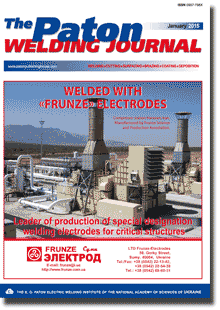| 2015 №01 (02) |
DOI of Article 10.15407/tpwj2015.01.03 |
2015 №01 (04) |

The Paton Welding Journal, 2015, #1, 18-23 pages
EVALUATION OF OPERABILITY OF THE MAIN PIPELINE WITH LOCAL WALL THINNING AT REPAIR BY ARC SURFACING
E.A. Velikoivanenko, G.F. Rozynka, A.S. Milenin And N.I. Pivtorak
E.O. Paton Electric Welding Institute, NASU. 11 Bozhenko Str., 03680, Kiev, Ukraine. E-mail: office@paton.kiev.ua
Abstract
Welding surfacing is one of the most rational methods of repairing the main pipelines without taking them out of service, particularly in the case of the need to eliminate typical defects of local metal loss through corrosion. Here welding application on a pipeline, which is at high internal pressure, envisages a thorough optimization of technological parameters of this process in terms of safety and effectiveness of repair-and-renewal operations, in particular, on the base of the results of modeling the occurring physico-mechanical processes kinetics. In this study a package of tools was developed for mathematical modeling of the process of multipass welding surfacing of thinning defects of the main pipeline elements to predict their technological strength and post-repair residual life. For this purpose an integrated approach of numerical analysis of the kinetics of temperatures, stress-strain state and processes of tough fracture of pipeline material has been implemented. A numerical criterion has been proposed, which allows, with a slight conservatism, prediction of formation of structure state, close to the limiting one, as well as guaranteeing the required load-carrying capacity of the pipeline, after repair of the detected defect of discontinuity type. The case of multipass surfacing repair of an inadmissible defect of the main pipeline wall thinning was used to study the characteristic peculiarities of the influence of the main technological parameters on the structure technological strength and its residual life. 17 Ref., 1 Table, 6 Figures.
Keywords: arc surfacing, main pipeline, defect, local wall thinning, repair under pressure, safety of repair-and-renewal operations, plastic instability, tough fracture
Received: 03.07.14
Published: 28.02.15
References
1. Amend, B., Bruce, W.A. (2013) Welding on in-service pipelines: Dispelling popular myths and misconceptions. Welding Assoc. J., 2, 30-39.
2. LaMorte, C.R., Boring, M., Porter, N. (2007) Advanced welding repair and remediation methods for in-service pipelines: Final Report. Columbus: EWI.
3. Sabapathy, P.N., Wahab, M.A., Painter, M.J. (2000) The prediction of burn-through during in-service welding of gas pipelines. Int. J. Press. Vess. Piping, 11, 669-677. https://doi.org/10.1016/S0308-0161(00)00056-9
4. Makhnenko, V.I., Milenin, A.S. (2009) To problem of repair of land main in-service pipelines. In: Proc. of Sci.-Techn. Seminar on Service Reliability Control of Pipeline Transport Systems (10-11 June, 2009, Kiev, Ukraine), 12-18. Kiev: PWI.
5. Makhnenko, V.I., But, V.S., Velikoivanenko, E.A. et al. (2001) Mathematical modeling of pitting defects in active oil and gas pipelines and development of a numerical method for estimation of permissible parameters of arc welding repair of defects. The Paton Welding J., 11, 2-9.
6. VBN V.3.1-00013471-07:2007: Main pipelines. Methods of repair of defective zones. Kyiv: Ministry of Fuel and Energy of Ukraine.
7. STO Gazprom 2-2.2-136-2007: Instruction on welding technologies in construction and repair of industrial and main pipelines. Pt2. Moscow: VNIIGAZ.
8. Kiefner, J.F., Bruce, W.A., Stephens, D.R. (1994) Pipeline repair manual. Houston: Technical Toolboxes.
9. Boring, M.A., Zhang, W., Bruce, W.A. (2008) Improved burn-through prediction model for in-service welding application. In: Proc. of 7th Int. Pipeline Conf. (Sept. 29-Oct.3, 2008, Calgary, Alberta, Canada), Vol. 3, 249-259. New York: ASME.
10. Painter, M., Sabapathy, P. (2000) In-service welding on gas pipelines: Program Report. Clayton: CSIRO Manufac. Sci. & Techn.
11. Makhnenko, V.I. (1976) Calculation methods for investigation of welding stress and strain kinetics. Kiev: Naukova Dumka.
12. Makhnenko, V.I. (2006) Safety service resource of welded joints and assembly units of modern structures. Kiev: Naukova Dumka.
13. Karzov, G.P., Margolin, B.Z., Shvetsova, V.A. (1993) Physical-mechanical modeling of fracture processes. St.-Petersburg: Politekhnika.
14. Velikoivanenko, E.A., Rozynka, G.F., Milenin, A.S. et al. (2013) Modelling of processes of nucleation and development of ductile fracture pores in welded structures. The Paton Welding J., 9, 24-29.
15. Tvergaard, V. (1990) Material failure by void growth to coalescence. Adv. in Appl. Mech., 27, 83-151. https://doi.org/10.1016/S0065-2156(08)70195-9
16. DSTU-N B V.2.3-21:2008: Directive. Determination of residual strength of main pipelines with defects. Kyiv: Minregionbud.
17. SNiP 2.05.06-858: Main pipelines. Building norms and acts. Moscow: VNIIST Minneftegazstroya.
Suggested Citation
E.A. Velikoivanenko, G.F. Rozynka, A.S. Milenin And N.I. Pivtorak (2015) Evaluation of operability of the main pipeline with local wall thinning at repair by arc surfacing. The Paton Welding J., 01, 18-23.The cost of subscription/purchase order journals or individual articles
| Journal/Currency | Annual Set | 1 issue printed |
1 issue |
one article |
| TPWJ/USD | 384 $ | 32 $ | 26 $ | 13 $ |
| TPWJ/EUR | 348 € | 29 € | 24 € | 12 € |
| TPWJ/UAH | 7200 UAH | 600 UAH | 600 UAH | 280 UAH |
| AS/UAH | 1800 UAH | 300 UAH | 300 UAH | 150 UAH |
| AS/USD | 192 $ | 32 $ | 26 $ | 13 $ |
| AS/EUR | 180 € | 30 € | 25 € | 12 € |
| SEM/UAH | 1200 UAH | 300 UAH | 300 UAH | 150 UAH |
| SEM/USD | 128 $ | 32 $ | 26 $ | 13 $ |
| SEM/EUR | 120 € | 30 € | 25 € | 12 € |
| TDNK/UAH | 1200 UAH | 300 UAH | 300 UAH | 150 UAH |
| TDNK/USD | 128 $ | 32 $ | 26 $ | 13 $ |
| TDNK/EUR | 120 € | 30 € | 25 € | 15 € |
AS = «Automatic Welding» - 6 issues per year;
TPWJ = «PATON WELDING JOURNAL» - 12 issues per year;
SEM = «Electrometallurgy Today» - 4 issues per year;
TDNK = «Technical Diagnostics and Non-Destructive Testing» - 4 issues per year.


